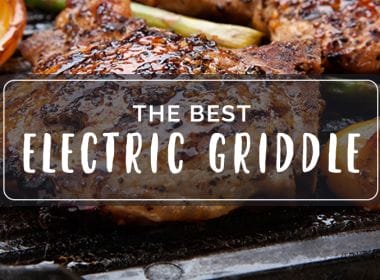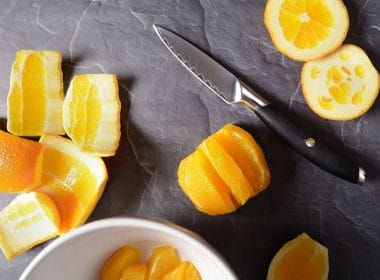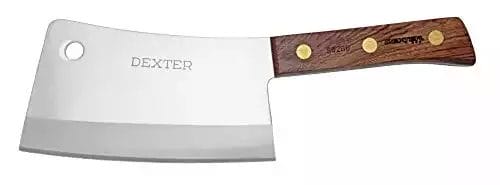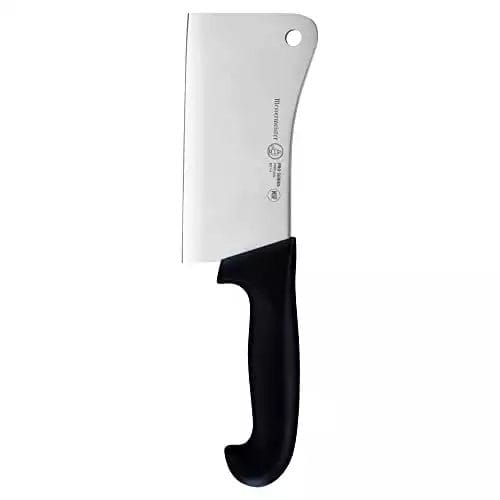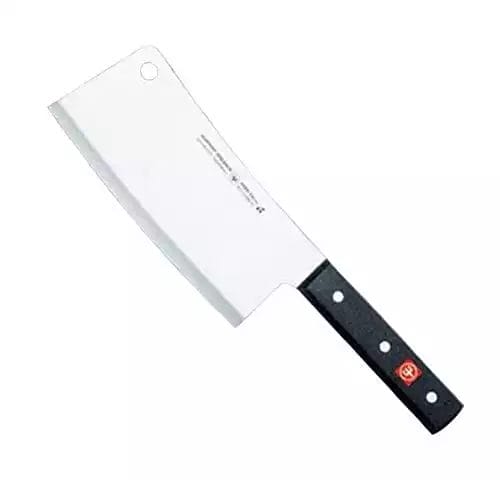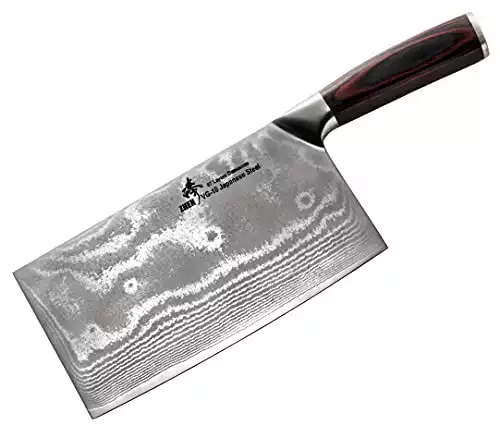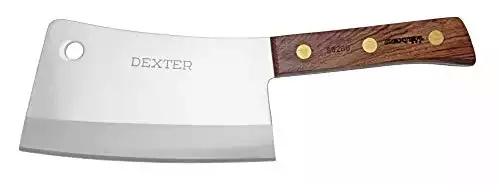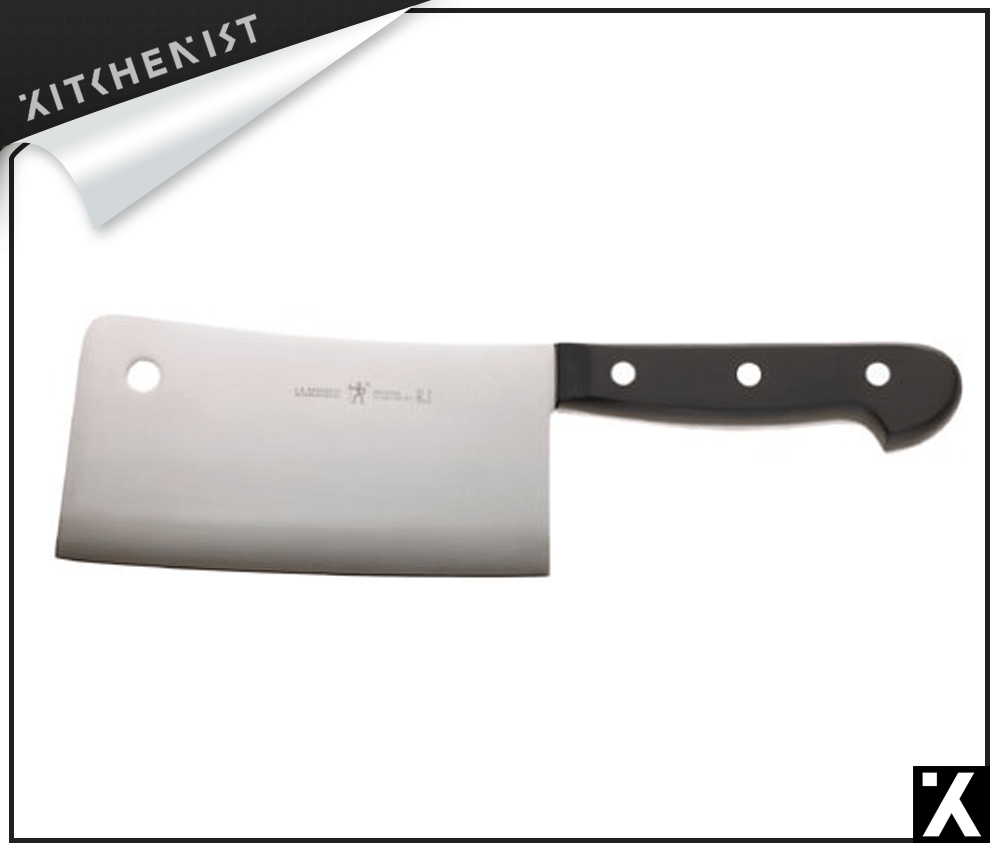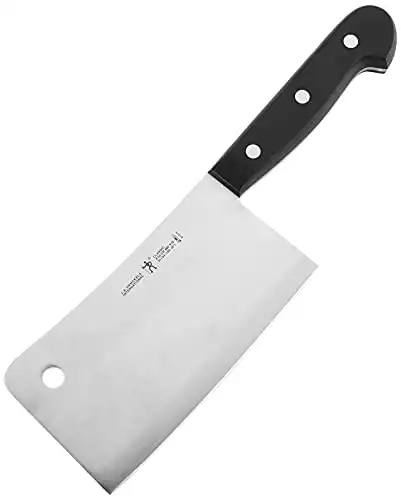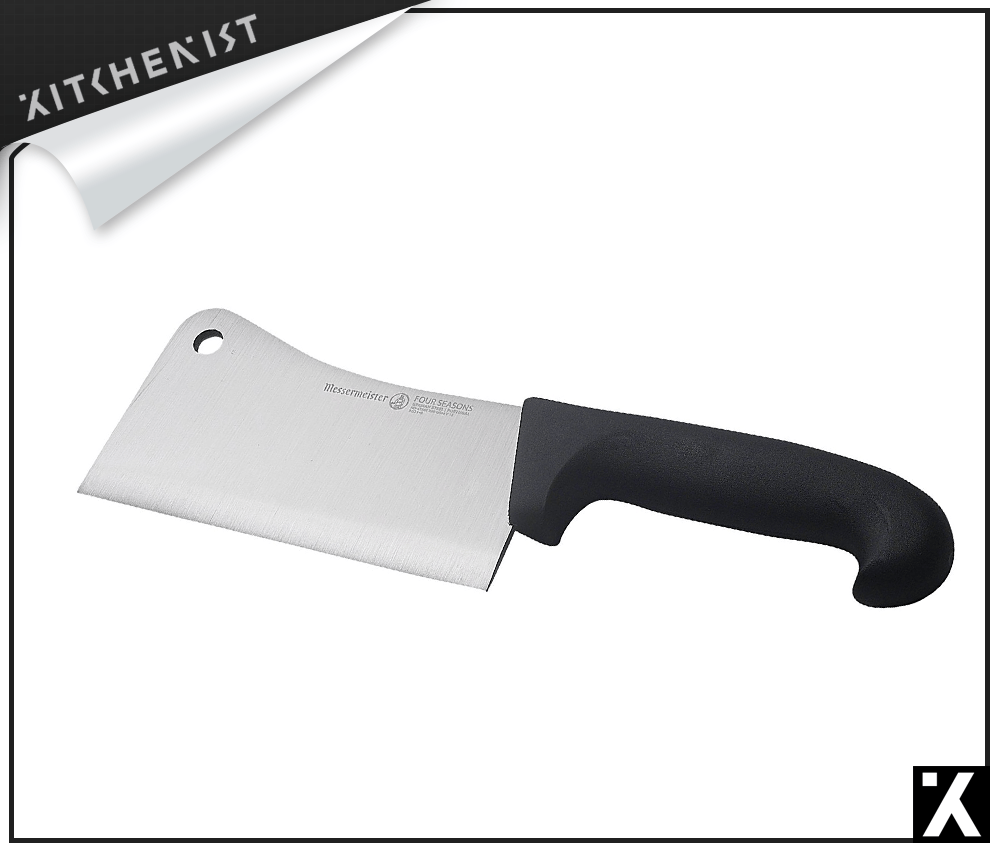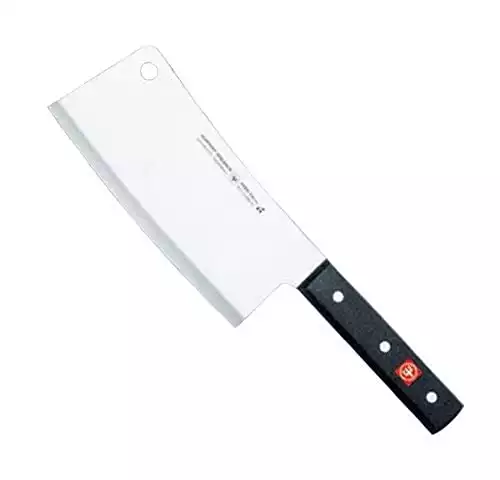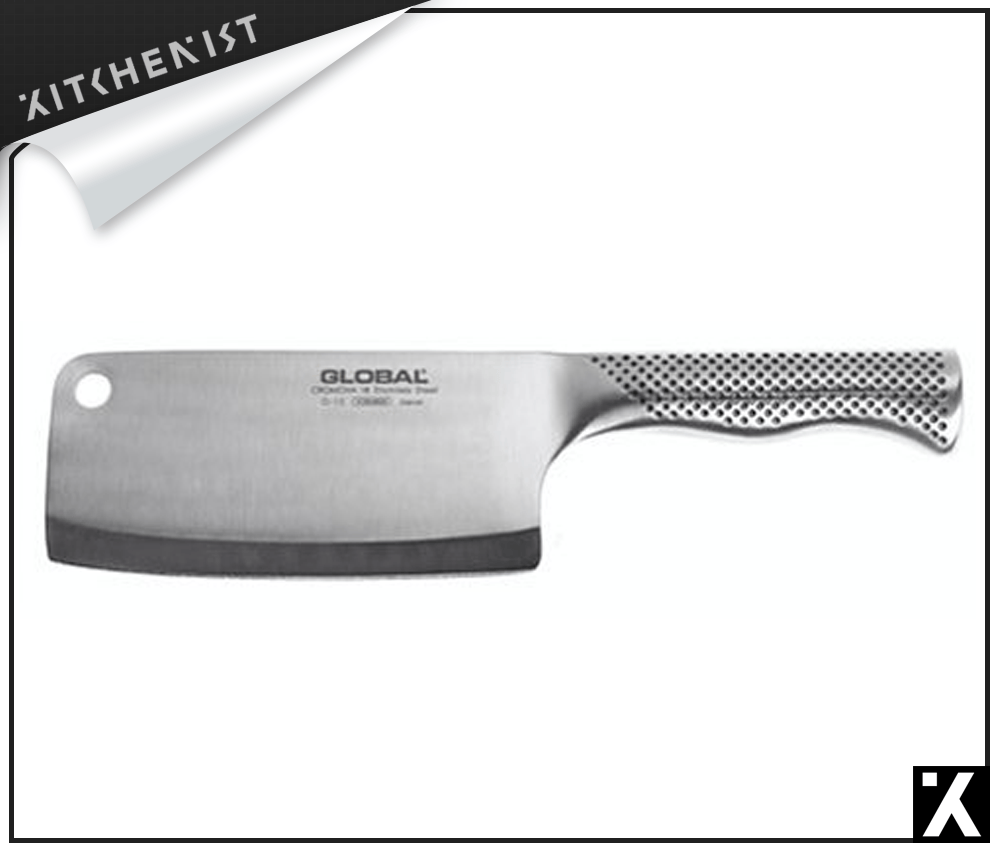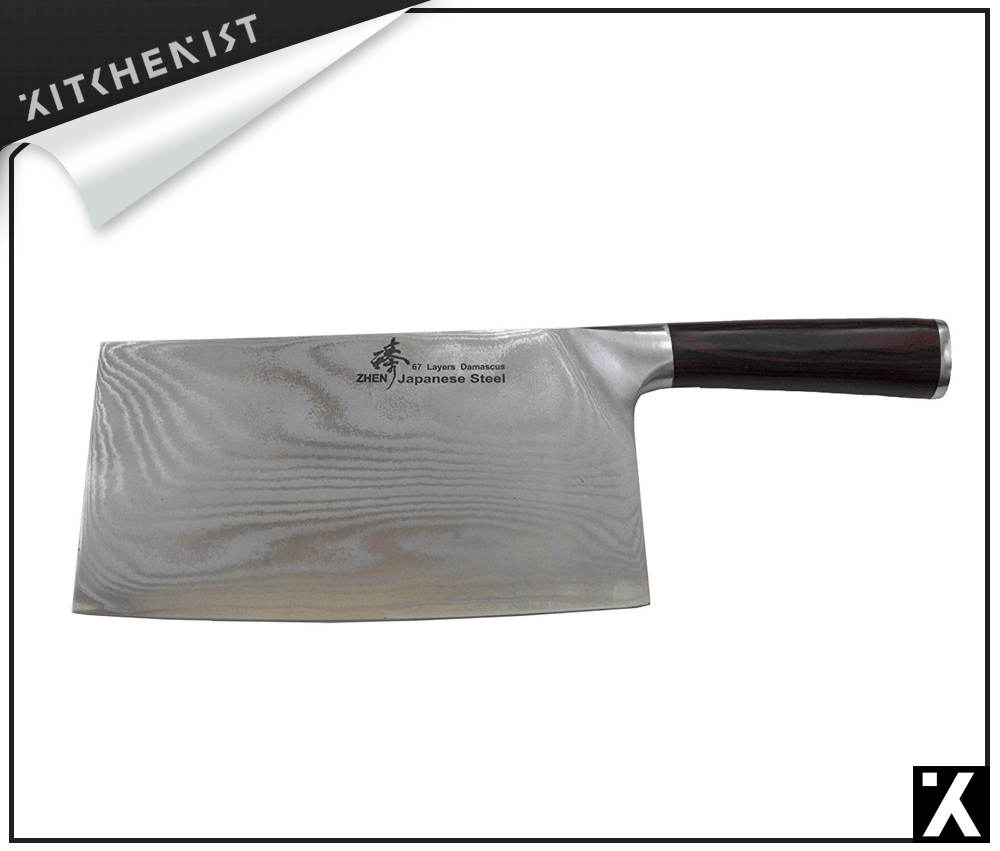Walk into any professional kitchen, you’ll find an array of tools to help chefs create sumptuous dishes for waiting diners. Among those will typically be a fillet knife, a paring knife, a chef’s knife, and a meat cleaver.
Chefs skillfully wield their knives to slice and dice and remove unwanted innards all in preparation for the cooking phase. There’s much finesse shown in how they use their knives which stand at odds with the simple kitchen cleaver.
When needing to cut through a meaty chunk of goodness, the simple cleaver is the chef’s tool of choice. Cutting through animal flesh and bone, you don’t want to use delicate tools that could become damaged or injure the chef in their use.
The cleaver is a straightforward implement to cut a carcass into manageable sections before the more delicate work begins. These are rough no-nonsense tools for a specific purpose.
Note: if you are looking for the best steak knives then look no further.
What you need to know
The Good
- Cut through bone, cartilage and whole chickens quickly
- Portion out poultry and meat ready for careful meal preparation later
- Hefty blades with sturdy handles make light work of dense bones that a chef’s knife cannot cut through
- Stain-resistant carbon-based blades made in Germany or Japan are the best
- Single pieces of steel used to die-cut a blade ensures strength and long-term durability
- Cleavers are available in many sizes and weights to suit different arm strengths
The Bad
- Cheap blades don’t last
- Thin blades for meat cleavers aren’t as effective
- Cheap imports use inferior steel for their blades
- Weak handles come apart easily
- Poorly balanced cleavers aren’t effective
- Not generally useful for general cutting duties in food preparation
Our Best Rated Meat Cleavers of October, 2023
The winner is the Dexter-Russell 8-inch cleaver. The high-carbon stainless-steel, rosewood handle held together by brass rivets, and its pure cutting force makes this cleaver a clear choice. Excellent balance, sufficient heft in the hand, and brutal efficiency are the hallmarks of this product.
Dexter-Russell (S5288) 8″ Heavy-Duty Cleaver Review
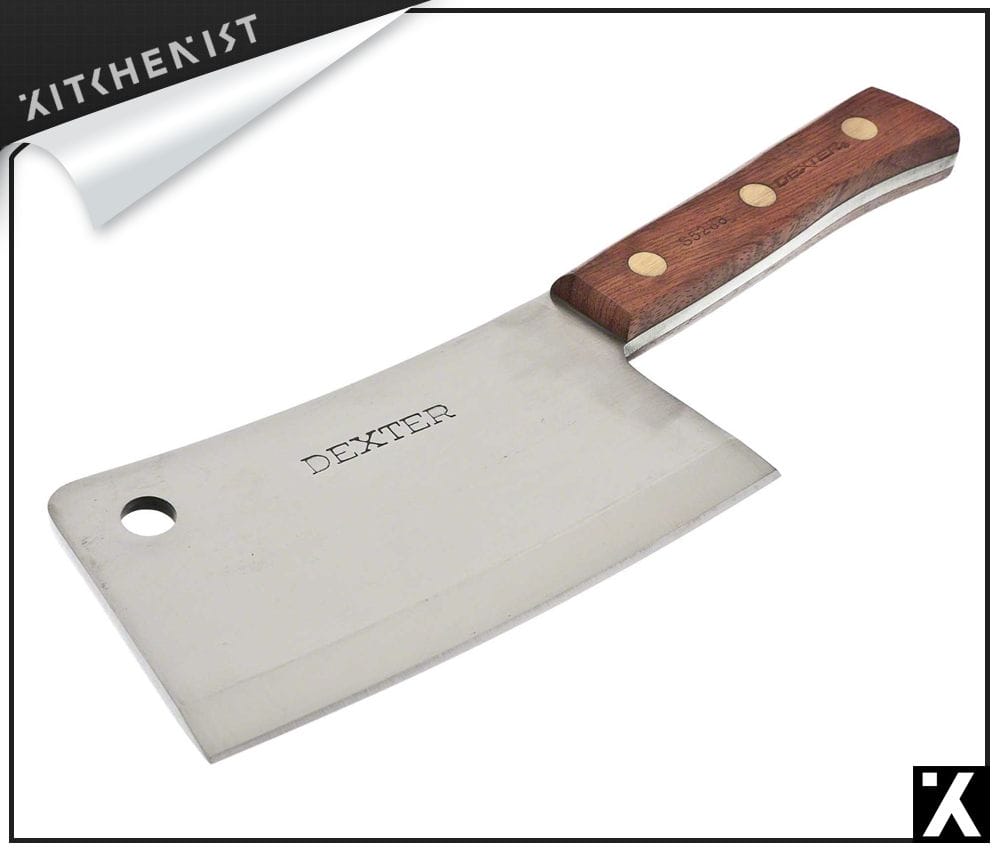
The Dexter-Russell is an 8-inch kitchen cleaver designed for heavy chopping through the toughest of bones. There is little that this blade cannot slice through easily.
The heavy-duty cleaver weighs 2.5 pounds, so it’s surprisingly hefty in the hand but because of this, it packs a punch when cutting through bone.
The brand is well-known for its smartly designed knives and quality over the years. It’s stated as made in the USA, but it’s actually produced in China.
Size & Materials
- Rosewood handle is 6.5-inches long
- High-carbon steel blade that’s resistant to stains
- Full blade is 8-inches long
- Blade is 4.5-inches in height
- Blade is 1/4-inch thick
Pros
- Hefty cleaver to defeat bone easily
- Durable steel built to last
- Lovely rosewood handles with three brass rivets
- Smooth side for smashing garlic cloves
- Blade tip is flat
Cons
- Handle shape won’t be to everyone’s liking
- Sometimes too large and unwieldy for chefs with smaller hands or people with arthritis
Henckels Classic 6-inch Cleaver Review
The Henckels Classic 6-inch Cleaver is a dishwasher-safe full-tang meat cutting tool. The high-carbon stainless-steel from Germany uses forged hot blades for added strength. The triple rivets on the handle with a curved end ensure the handle stays rigid. The product is made in Spain.
There’s a hole in the blade to hang the cleaver when not in use. The Henckels knives are well-known for dependability and come with a lifetime warranty.
Size & Materials
- Weighing 11.85 ounces (0.740 pounds)
- Measures 2 5/8-inches at the handle and 2 7/8th-inch at the end
- High-carbon stainless-steel forged from Germany
- Triple rivet handle
Pros
- Sharp meat cleaver
- Tough carbon stainless-steel
- Hole in the blade to hang it up
- Excellent balance
Cons
- Not always enough heft to cut thickest bones
- Handle isn’t completely smooth
- Surprisingly small and not ideal for people with large hands
Messermeister Four Seasons 6-inch Heavy Meat Cleaver Review
The Messermeister Four Seasons 6-inch cleaver (there’s also a 7-inch version) has a stamped steel blade that makes short work of poultry and beef bones. One piece of steel alloy is used to craft the blade which is delivered with a razor-like edge for easy slicing.
The 3 ¼-inch width of this blade is ideal for pushing down on garlic cloves and crushing other ingredients quickly rather than using a specialized tool.
Size & Materials
- Die-cut German 1.4116 stainless carbon alloy steel blade
- Blade is 6-inches long (there’s also a 7-inch model)
- Blade thickness is 3 ¼-inches
- Polypropylene molded handle for greater hygiene
Pros
- Stainless steel from Germany that you can depend on
- Blade has a Rockwell rating of 56-57
- Curved angular blade at the top with a hole to hang the cleaver up
Cons
- Assembled in Spain, not Germany
- The polypropylene handle won’t suit people who prefer wooden handles for their knife collection
Wüsthof 6-inch Classic Cleaver Review
The Wüsthof Classic cleaver is a 6-inch model (there are 8-inch, 9-inch, and 16-inch versions too) made from German stainless steel. The Precision edge technology from Wüsthof provides a cutting edge that’s up to 20 per cent sharper with 200% improved sharpness retention.
This full-tang cleaver is heavy-duty one suitable for almost all bone cutting requirements. The blade with its 14-degree cutting angle on either side allows for fine cutting as well as brute force cleaver usage too.
The blade is buffed up and given a finishing polish by the craftsman in Germany before being boxed up.
Size & Materials
- Blade length is 6-inches
- Blade handle is 5 ¼-inches long
- One piece of steel used to create the blade
- Polypropylene molded handle
- Weighs 1 pound, 4 ounces
Pros
- German stainless-steel blade made from high-carbon materials
- 20% sharper edge and 200% improved edge maintenance
- Cuts through thick bones due to Cleaver’s heft
- Made in Germany
Cons
- Polypropylene molded handle won’t suit chefs who prefer wooden handles
Global G-12 6 ½ inch 16cm Meat Cleaver Review
The Global G12 is a 6.5-inch kitchen cleaver, it’s a stainless-steel model which looks and feels different to other ones. It has a distinctly square shape to it given the shorter blade length than many competitor’s cleavers.
At only 1.3 pounds with a shorter blade, the risk is that this knife won’t cut through thicker or denser bones as effectively. The knife lacks a bit of heft but does have sharper edges for improved cutting performance.
Size & Materials
- Blade length is 6.5-inches
- Wholly made with stainless-steel
- Weighs only 1.3 pounds
Pros
- Blade is square-shaped
- Bolster-less design with no separate parts to come apart
- Blade edge sharpened at 15-degree angle
- Nicely balanced, patterned hollow handle with grips to avoid slippage
- Hole to hang the cleaver up
Cons
- Shorter blade than some other cleavers
- Won’t cut through thicker bones as effectively
ZHEN Japanese VG-10 67-Layer Damascus Steel 8-Inch Cleaver Review
The Zhen VG-10 cleaver is a little different to other meat cleavers we have reviewed. The Damascus steel has 67 layers (33 on either side) and has a 60 to 62 hardness rating. The pattern evident on the blade improves resistance to stains and stops food sticking as easily.
The cleaver is not really designed to chop through meat bones. It is more of a sharp cutting implement for different types of produce. The Pakkawood handle widens at the end for a completely different feel to other cleavers. This model is suitable for slicing, chopping produce, and as a butcher’s knife.
Size & Materials
- Japanese VG-10 stainless-steel with 67-layers
- Hardness rating of 60-62
- Blade length is 8-inches
- Blade width is 4-inches
- Blade thickness is 0.75-inches
- Pakkawood shaped handle
Pros
- Top-grade Japanese stainless-steel used for the blade
- Waterproof, bacteria-resistant Pakkawood handle
- Resistant to rust and stains on the blade
Cons
- Not able to chop through bones
- More of a slicing and cutting knife than a Cleaver
What is a meat cleaver?
The meat cleaver is the tool that is often found in the collection of knives in the kitchen but not seen too often. However, it’s a vital tool for every chef or cook.
There are only a few knives that are important to have in every kitchen. These are the chef’s knife, a paring knife, a fillet knife, a utility knife, and a serrated bread knife. For professional sushi chefs, there are specialized knives for preparing this type of meal. Outside of sushi, the kitchen cleaver makes six, though not every kitchen has this cutting tool in its arsenal.
The cleaver knife is a large, broad implement made from toughened steel and either strong wooden or plastic handles that stand up to heavy downwards strikes to cut bone and other tough parts. Unlike with other knives, the blade is sometimes blunt with the downward force of the chef’s swing providing the cutting force. Some Cleavers do have a sharp blade which depends on the manufacturer’s approach to their product.
There’s a simple violence of action to the way a good chef wields the mighty meat cleaver to chop through carcasses, tough beef bones, and chicken thighs as if they’re paper thin. Anyone walking past the window of a Chinese restaurant will often see chefs chopping through duck and other birds with a kind of spare savagery that’s startling the first time you witness it.
A cleaver is mostly a tool used to chop up meat and poultry into manageable sections ready for preparation before cooking. Vegetarian, vegan and fruitarian chefs will often have little use for a meat cleaver; tofu isn’t tough to slice or cube!
Things to consider
There are a few things to think about when it comes to selecting the right meat cleaver for your kitchen:
Blade Width
The six or eight-inch blade width is the most common in the kitchen cleaver market. However, some manufacturers like Wüsthof produce their Classic Cleaver model in various sizes from 6-inches up to 16-inches in their largest size.
The longer width allows you to chop through a large slab of meat with a single downward stroke and not need several chopping actions. Also, for people with significantly larger hands, they may prefer bigger sizes with larger handles.
A longer blade width is useful to use the edge of the blade and push down on cloves of garlic to crush them or squash down herbs or vegetables.
Blade Height
The blade height doesn’t matter quite as much as its length. Available cleavers tend to be inconsistent in their design when it comes to their height. Some blades are rectangular almost to the point of appearing square because their height is significant. Other blades are longer and slimmer.
Where the height of the blade becomes a factor is the size of the meat or poultry that is being cut through. For instance, it is easy to cut roughly in a straight line with a taller blade.
Blade Thickness
Thicker blades are easier to provide the kind of blunt force needed to chop through dense bone. Thinner blades may warp or waiver when cutting through bone. Look for a thicker blade with a meat cleaver.
Balance
The balance of a meat cleaver in the hand is a personal thing, but matters to any regular user. The length and weight of the handle versus the weight of the blade either create a balance that feels right in the hand or it doesn’t.
Regardless of the size of the cleaver, the balance should still feel properly weighted to allow a smooth arching cutting action to hit the right spot with every chopping motion.
Weight
The weight is separate to the balance in the hand because depending on the arm strength of the person using the cleaver, a product can simply be too heavy for them to use effectively.
Another factor with the weight is that a cleaver must have sufficient overall heft to strike forcefully enough to carve efficiently through bone, cartilage, and muscle with a single strike.
Type of Steel
The best steel is either German or Japanese. Opinions vary as to the better kind. Both are dependable.
Some cleavers have high carbon, stainless steel blades. A few use the original lot 1.4116 steel alloy which is tougher. Sometimes blades are heat-treated and then cooled to make them stronger. Better blades are die-cut from one billet of stainless steel alloy.
The use of stainless steel provides resistance to corrosion and stains on the blade. Care must still be taken to clean and dry the blade after use to avoid unnecessary corrosion due to water.
Sometimes a blade is rated based on its Rockwell level. A 58 Rockwell rating is one of the hardest blades on Earth and will cut impressively through good-sized bones with ease.
Handle
The handles for a cleaver are usually 3-rivet ones in a wooden handle (rosewood or another species). A wooden handle is more common with a cleaver and is less likely to slip in the hand.
With some manufacturers, they prefer to use polypropylene handles that are hygienic and molded to the same shape every time. A polypropylene version is a little more likely to slip in hot hands in a cramped kitchen.
Blade Edge
It depends on the manufacturer whether the blade will be blunt or sharp.
Some cleavers that have blunt blades are easier to manage because they don’t need sharpening and never lose their effectiveness.
With sharp blades, they may use lasers to verify that the edge is equally sharp all the way along the blade. Carbon-steel with sharp edges requires re-sharpening often to return to its out-of-the-box condition. Depending on the frequency that the cleaver is deployed, the blade could become dull at just the wrong time.
History of the Knife Brand
Many famous knife brands have produced their products for generations. In some cases, for over two centuries crafting strong steel and wood into dependable cutting knives for chefs around the world to use skillfully in their kitchens.
Whilst the simple fact that a knife company has been in business for a long time is not a guarantee that their product is the best, it is a good indicator that they’re doing something right.
To this day, the most sought-after knives are made either by Japanese or German producers with chefs often swearing by the knives of a certain manufacturer above all others.
FAQ: Meat Cleavers
The hole is there to either hang up the cleaver when it’s not needed or to hang it on the belt of the butcher. With the butcher, there’s a strong belief the blade will become duller if laid flat.
A Chinese cleaver is thinner than a meat cleaver. Because of this, it is used to cut through softer foods and not only chop through bone.
A meat cleaver is better for chopping through mid-sized bones with relative ease and does so adroitly. With carcasses with large bones, a butcher shop typically uses either a bandsaw or an axe to cut the animal down to a manageable size that a cleaver is usable on.
Chinese cleavers are graded for thickness from 1 through 4. A meat cleaver is fairly close to a thickness level of 1 for a Chinese cleaver.
These are also Japanese cleavers with a different numbering system, but anything higher than a level 4 is too thin to cut through bone.




